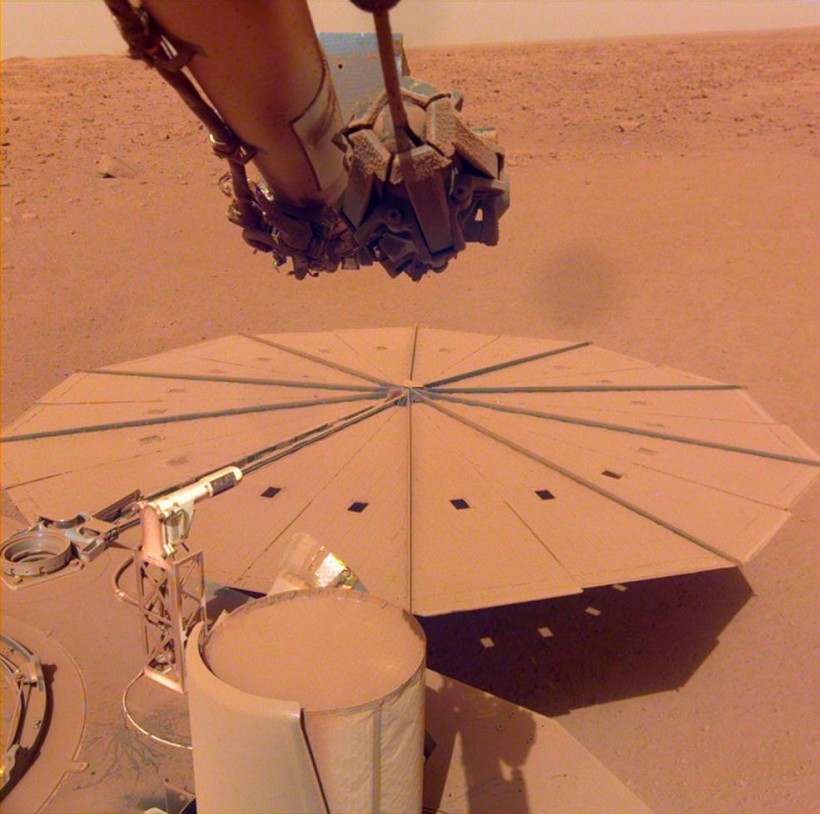The NASA InSight lander, which has been exploring Mars' enigmatic innards since 2018, is nearing the conclusion of its mission.
Kathya Zamora Garcia, InSight deputy project manager at NASA's Jet Propulsion Laboratory in Pasadena, California, said in a CNN report that the mission will stop scientific activities due to a declining power supply.
Despite the mission team's best efforts, the solar panels on InSight have been progressively blanketed in red Martian dust. As Mars enters winter, additional dust will be lofted into the atmosphere, exacerbating the problem.

InSight captured this image of one of its dust-covered solar panels on April 24, 2022, the 1,211th Martian day, or sol, of the mission.
Martian Dust Officially Kills NASA InSight Lander
Even though it is losing power, the InSight (Interior Exploration using Seismic Investigations, Geodesy, and Heat Transport) continues to search for Marsquakes.
NASA said on Tuesday that its science operations would stop later this summer and that Insight's crew anticipates the lander to be inoperable by December.
InSight will end its mission with over 1,300 marsquakes, including a recent mega quake of magnitude 5 that struck the planet on May 4 and was also located in shock-prone areas.
This mission's functioning is primarily reliant on solar power, which becomes a limiting problem when dust obstructs sunlight. NASA said some months ago that the InSight Mars lander will likely be retired by the middle of 2022.
ALSO READ: NASA Mars InSight Lander Detects 2 Giant Marsquakes in the Far Side of Red Planet
The mission was extended because of its substantial scientific significance. However, the lander's weight and power considerations prevented it from installing dust-brushing equipment, like motors or brushes.
Even in 2021, engineers were able to clean some dust from a solar panel by sprinkling sand on the spaceship and allowing the wind to blow it away. The dust has accumulated in the lander due to the lack of a strong breeze.
What's Next For This Mission
The Mars lander was outfitted with solar panels that generated roughly 5,000 watt-hours each Martian day when it landed on the Red Planet on Nov. 26, 2018, enough to operate an electric oven for at least an hour and 40 minutes. However, it has produced around 500 watt-hours of electricity every sol, which is just enough for a 10-minute oven.
Seasonal changes are also taking hold in Elysium Planitia, Insight's homeworld. NASA predicts darker skies ahead, with more dust in the air suffocating sunlight and reducing the lander's energy. To keep its vitality, the mission would need a powerful dust-cleaning event like a "dust devil" or a passing whirlwind.
The mission's team will also place InSight's robotic arm in its "retirement stance" for the last time this month due to its low energy.
According to NASA, the team will continue to collect more data on Mars over the following six months. It will finalize the "Mars quake catalog" and its models. Their data will be transferred to a public repository, where all specifics about the soon-to-be-retired space project will be preserved in perpetuity.
Scientists have relied on InSight's gathering of Marsquakes to determine the depth and composition of the Red Planet's crust, mantle, and core.
RELATED ARTICLE: Solar Power More Preferred Than Nuclear Technology on Mars, But Here's The Catch!
Check out more news and information on Space in Science Times.














